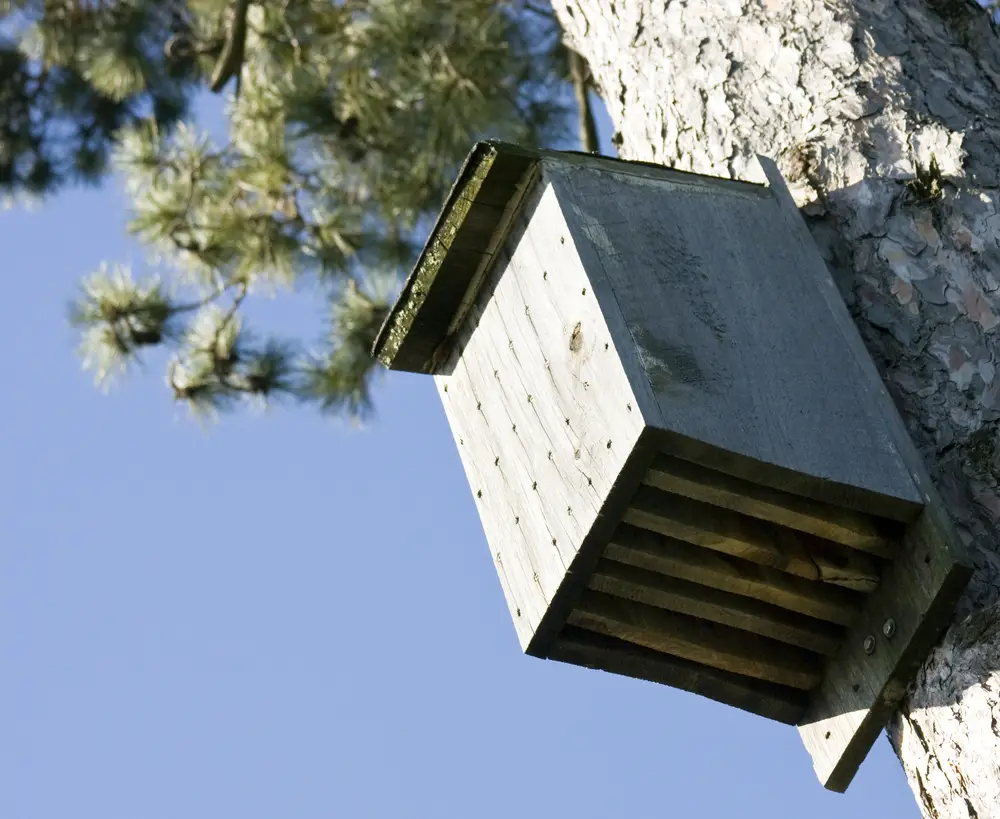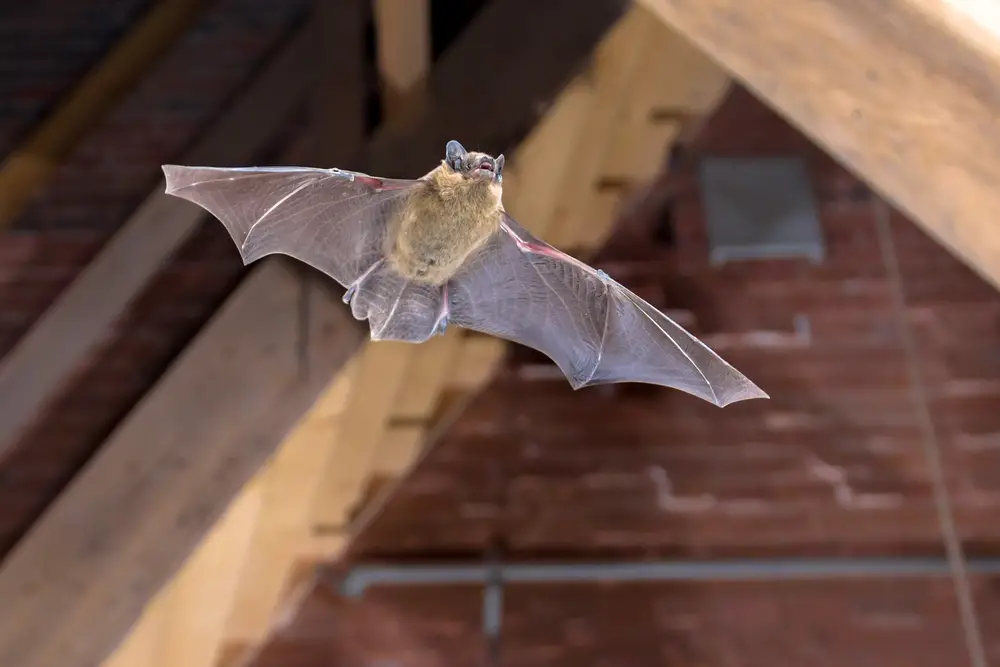Bats may be beneficial creatures in terms of controlling insects, but it can be quite unnerving to have them residing in close proximity to your home.
One common location for bats to roost is behind shutters, which provide shelter and safety from predators.
Quick Answer:
- Inspect: Confirm the presence of bats and their exact location. This is typically done at dusk when bats leave for feeding.
- Exclusion Device: Install a one-way exclusion device that lets bats exit but not re-enter.
- Seal Entry Points: After confirming all bats have exited (2-3 days), seal the entry points with caulk or mesh.
- Clean-Up: Clean and disinfect the area to remove any bat droppings.
If the bat problem persists, or if you’re uncomfortable with the process, seek help from a professional pest removal service.
Certain species of bats are protected by law, and it is crucial to adhere to these regulations as well as treat the animals humanely.
Identify the Bat Problem
Bats are beneficial creatures that play a significant role in controlling insect populations. However, when they decide to take up residence behind your home’s shutters, it can become a problem for homeowners.
Identifying the bat problem is the first step in getting rid of them.
Start by observing the area around your shutters. Bats like to roost in small, dark, and warm spaces. If you notice droppings or observe bats flying in and out, you most likely have a bat roosting behind your shutters. The droppings, also known as guano, can be a health hazard and contribute to unpleasant odors.
It’s important to determine the type of bat you’re dealing with, as some species are protected by law. Common species you may find include the little brown bat, big brown bat, and pallid bat. To identify the species, you may need to consult with a local wildlife expert or research online.
Once you’ve identified the bat problem and know the species involved, consider the best course of action. Using naphthalene or mothballs is not recommended, as they can be harmful to bats and other wildlife. White phenol can be used as a deterrent but should be applied carefully and in accordance with local regulations.
Remember to approach the situation with care and respect for the bats, as they are essential contributors to the local ecosystem.
Understanding the Benefits of Bats
Bats are often misunderstood creatures and can be seen as a nuisance. However, they play essential roles in our ecosystem and provide various benefits.
Before attempting to get rid of bats behind your shutters, it’s crucial to understand why they’re important and useful to us.
One of the most significant benefits that bats provide is pest control. They are highly efficient when it comes to consuming large amounts of insects, including mosquitoes and other pests that can transmit diseases or damage crops.
Adult bats can eat up to their body weight in insects each night, reducing the insect population and helping to maintain the balance in our ecosystem.
Another advantage of having bats in the environment is their contribution to plant pollination and seed dispersal. Some bat species feed on nectar and, as a result, inadvertently spread pollen from one flower to another.
This process is vital for the reproductive success of many plant species. Additionally, fruit-eating bats play a crucial role in dispersing seeds, which in turn helps support plant diversity and forest regeneration.
A lesser-known benefit of bats comes from their droppings, known as guano. Bat guano is rich in nutrients like nitrogen, phosphorus, and potassium, making it an excellent natural fertilizer for plants.
Since these nutrients are essential for plant growth, farmers and gardeners worldwide value bat guano as an environmentally friendly alternative to chemical fertilizers.
Legal Considerations and Protected Species
Before taking any action to remove bats from behind your shutters, it’s essential to understand the legal considerations and protected species regulations in your area. In many countries, bats are considered protected species due to their ecological importance and declining populations.
When dealing with protected species, it is crucial to seek professional help from a licensed wildlife control expert. These professionals are trained to handle bats humanely and ensure they are not harmed during the removal process.
Attempting to remove bats on your own may result in violations of wildlife protection laws, which can lead to fines and penalties.
It’s also important to consider the maternity season when dealing with bats. Bats breed at certain times of the year, and during these periods, some countries have specific laws that prohibit disturbing bat colonies.
Make sure to consult with your local wildlife agency or a licensed wildlife control professional to minimize the impact on the bat population during this sensitive time.
Finally, always opt for wildlife removal methods that are considered humane and non-destructive. Using chemicals or methods that may harm the bats is not only inhumane but may also be illegal.
Friendly and non-invasive techniques should be used to encourage bats to leave your shutters voluntarily.
Discouraging Bat Roosting
Using Light
Installing bright lights near the shutters can help discourage bats from roosting. Bats prefer dark and secluded areas, so keep the area well-lit, especially at night. You can use solar-powered or motion-activated lights to save energy and avoid disturbing neighbors.
Using Repellents
There are various repellents you can use to deter bats from roosting behind your shutters. Some common ones are:
- Cinnamon: Sprinkling cinnamon around the shutters can help repel bats due to its strong smell. Reapply as needed, especially after rain.
- Bat repellents: There are commercial bat repellents available, such as sprays and ultrasonic devices. Always follow the manufacturer’s instructions when using these products.
- Sticky bird repellents: These repellents can also be effective against bats. Apply these products cautiously, as they can affect the surface on which they’re used.
- Screen: Installing a screen around the shutters can help prevent bats from entering the cavity behind the shutters. Make sure it’s properly secured and maintained to ensure effectiveness.
Avoid using bird repellents and trapping methods, as these might harm the bats and are not recommended for this purpose.
Installing Bat Houses

Providing alternative roosting sites, like bat houses, can help encourage bats to leave your shutters.
Place the bat houses in a location away from the house, preferably near a water source and at least 10-15 feet above the ground. This gives bats a suitable habitat without causing a disturbance to you.
Remember to:
- Select a bat house designed for the type of bats in your area
- Place it in a sunny location for adequate warmth
- Secure it properly to avoid falling or swaying
Exclusion Methods
Bats can be a nuisance when they find their way into our homes, especially behind shutters. However, it’s essential to use non-lethal methods to remove them safely, ensuring their well-being.
Here are some effective exclusion methods to help you get rid of bats from your home:
Sealing points of entry: The first step in bat exclusion is to identify all possible entry points used by bats. These might include small gaps in the shutters, chimneys, vents, or ridge caps.
Once identified, carefully seal these openings using materials such as caulk or expanding foam. Make sure to conduct this process at night when the bats have left to feed.
Installing screens: Attaching screens to vents and shutters can prevent bats from entering your home.
Choose fine mesh or netting material that allows air circulation while effectively keeping bats out. Make sure to attach the screens securely, covering the entire opening.
Using bat exclusion devices: There are several types of bat exclusion devices available in the market. These devices allow bats to leave your home but prevent them from re-entering.
Examples include one-way doors, tubes, and nets. Install these devices over the identified entry points, ensuring that bats can exit but cannot return.
Clean and Disinfect
Removing Waste and Building Materials
To get rid of bats behind shutters, start by cleaning the area thoroughly. Safely remove any waste, such as bat droppings (guano), which can be harmful to human health and contribute to structural damage.
Bat guano may contain the fungus that causes histoplasmosis, a respiratory disease. Wear gloves, a mask, and protective clothing while handling guano and other waste materials.
Additionally, remove any damaged building materials caused by the bats’ presence. This may include insulation, wood, or siding that has been compromised. Dispose of these materials according to local regulations.
Consider the following steps for safe removal:
- Locate the affected area(s) and ensure you have proper protective gear
- Carefully remove the guano and damaged building materials
- Seal removed materials in a plastic bag and dispose of them properly
Disinfecting the Area
After the waste and building materials have been removed, it’s essential to disinfect the area to eliminate any remaining traces of histoplasmosis or other contaminants. Use a solution specifically designed for cleaning up after bats, or create a DIY solution with a 10% bleach mixture.
When disinfecting the area, follow these steps:
- Ventilate the space by opening windows or doors, if possible
- Mix the disinfecting solution and transfer it into a spray bottle
- Generously apply the solution to the affected area, allowing it to soak for 10-15 minutes
- Use a scrub brush or cloth to remove any remaining stains or debris
- Rinse the surface with clean water, allowing it to dry completely before reassembling or resealing the area
Preventing Bats from Returning
To prevent bats from returning and roosting behind window shutters, take measures to seal any gaps or openings that may allow them to enter. Check the condition of the wood and repair or replace any damaged areas that could serve as entry points for bats.
One option for sealing is using caulk or foam sealant, which can be applied to any small gaps or cracks. Ensure all potential entry points are properly sealed to keep bats out and prevent them from causing a nuisance.
Remember not to use chemical pesticides, as they may be harmful to both humans and the bat population.
Instead, consider installing bat exclusion devices on your property. These devices allow bats to leave the roost but prevent them from re-entering. It’s essential to monitor the progress and ensure all bats have left before sealing the area permanently.
Exclude bats during bat-safe times, i.e., not during their breeding season or cold months when they may be hibernating.
Maintaining cleanliness around your property can also help to deter bats from returning. Bats are attracted to insects for food, so reducing the insect population around your home can make the area less appealing for them.
Turn off exterior lights at night since they attract bugs, and ensure you store garbage in sealed containers to limit potential food sources for insects.
Educate yourself and your community about the risks associated with having bats near residential areas. Bats are known carriers of rabies, and their presence can lead to a bat infestation or potential transmission of diseases. By promoting awareness, you can help protect the health and safety of your neighborhood.
Lastly, ensure that your window shutters are fitted securely and maintained properly. Keep the shutters in good condition by regularly cleaning and inspecting them for damage.
This proactive approach will minimize the chances of bats settling behind your shutters and will help you tackle any potential problems early on.


